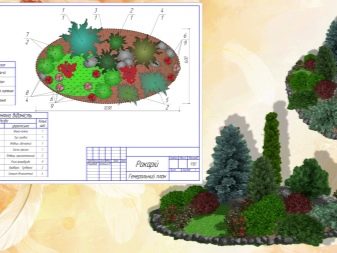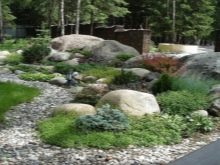Rockery at their summer cottage: the subtleties of landscape design

Rockery conquered the owners of country estates by the fact that the beauty of both stones and plants is revealed in an expressive rocky garden with a unique charm. At first glance, a complex structure may well be made with your own hands, taking into account the tastes of the owners of the site and emphasizing the individuality of the dacha.

What it is?
Rockery is a decorative composition for a garden space made of stones and plants. Trees, shrubs and flowers can be considered as floristic content. It is customary to plant dwarf and undersized varieties in rockeries.
Rockeries look best on elevation changes, terraces, slopes.
Although the artificial elevation given to the composition does not diminish the aesthetic effect. For the texture imitating the foothills, as a rule, large, impressive shades of stones and unpretentious, rather modest plants are planned. This combination emphasizes the closeness to the natural range of colors.



A very important point is the implementation of the drainage system. If the owner of the site copes with it, then he will master the rest for sure.
At the same time, an amateur artist has the right to give full play to his imagination and mood. The compositional atmosphere can look harsh, "northern" or more relaxed, poetic.
The most humble rockery looks like a few themed seedlings (for example, low-growing coniferous shrubs), inscribed among a dozen stones. Instead of them, it is quite possible to use climbing plants or forest plants - violets, ferns, elegant herbs and even burdocks.


If you set out on a multi-level garden in stones, then it will take much more time and effort. And fans of the mountain range in a country house with a waterfall will have to study the science of building such a composition, because you cannot put it into operation without retaining structures, a well-oiled mechanism for the functioning of a water body.



A few classic examples of rockeries:
Dachny
In the center of the site, a flower bed is laid out with stones, which immediately becomes the aesthetic center of the suburban space. Flowers make their way through the stones, and the brighter their bushes, the more elegant the composition. If you manage to create high walls of a flower bed from stones, then it is good to lower the climbing plants along them.

Garden
In the garden, a stony miracle can be more expressive and varied. Volumetric boulders mixed with small stones look interesting. Better if you manage to build a cascade, along which a stream gurgles, filling an artificial pond below. Pretentiousness in this case plays on the idea: the garden should "be surprised" by the rocky flower garden.

Room option
Yes, rockery in the room is also possible, in a country house as well. It is better to place a small building where there is more fresh air - on the veranda, balcony. If you make such a decision, then you will need a special platform and "foundation", and you will also have to take over "on watch" to maintain the light and humidity for the composition.

Peculiarities
To prevent disharmony in the landscape design of the site with the appearance of a rocky "mountain" with flowers and trees, it is better to take into account everything thoroughly in advance. Think over which stones you want to see, which plants please you more, how many square meters the finished composition will take.To carry out these calculations, it would be good for you to imagine the type of rockery.


There are a huge number of their types, we will list at least the most popular:
- Mini option. Suitable as an additional decoration for a recreation area. As an example - stones, herbs, at the top - a bush of bright barberry.
- On the slope. This rockery is good because it is very convenient for organizing the water element.
- Coniferous. This is a voluminous composition, which is a mound of stones and coniferous dwarf trees. Now it is a squeak of fashion among designers. Such beauty is located right in front of the house.




As for the functionality of rockeries, then such a subdivision as temporary rockeries or permanent, stable matters. The temporary option fits organically on a slope or flat surface. It will be necessary to dig a depression in order to root the seedlings of young ornamental shrubs and place small stones here.
For the construction of a stable stone flower garden, large boulders and small stones are installed "forever", the gaps between them are filled with greenery, which is better not requiring special care, but outwardly elegant. For example, spiraea, hosta, cinquefoil and other plants are perfect.



Fantasy natures are more to the liking of a changeable rockery. Large bright flowers are used for decoration, to which the owners gladly plant more and more every year.
Rockeries can be performed in different styles. A distinctive feature of English is the plants of pastel, non-stressful tones. The range is restrained, natural. No madness of colors, only needles and cereals. The stones are mostly gray, gray-white.




The European style includes local boulders and bright low flowers. Cineraria, curb phlox, tagetis, Californian poppy, starworm will look beautiful.
The Japanese style embodies a symmetrical arrangement of stones, where everything is verified and geometrically correct. Floristic elements, as a rule, are rare showy plants: dwarf sakura, rhododendrons, azalea hybrids.





The rocky garden is made up of hardy, zoned specimens. But from time to time, rockeries still need to be watered through a hose spray. And do not forget that every few years it is necessary to add soil and thin out the planting of flowers. After all, the main purpose of rockeries is aesthetics, therefore, at any time of the year, the composition should attract the attention of guests and hosts.


Basic rules for creating
If you are ready to create a stylish garden in stones at the dacha with your own hands, then take into account the moments that cannot be missed when decorating. Probably, the load will be considerable, but the pleasure from creative work with plants, stones, earth cannot be overestimated.
Do not build rockeries too close to home. After all, a garden in stones needs nature as a background, not brickwork.
Rains and drops, usually flowing from the roof of a building, can damage the structure of an artificial garden, wash out the ground, destroy plants and cause stones to settle.



Rockery also has no place under the spreading trees. Visually large tree shapes will "hammer" a rocky garden. Yes, and during the fall of leaves, problems with cleaning the flower bed will not be avoided.
The correct choice is a well-lit place, preferably a long, gentle slope. Shade part of your rocky garden; you don't need to expose the whole of it to the sun. Find a slope facing, say, southwest.
Do not neglect the area, which is modest in size. Pick up dwarf trees and get an expressive, pretty "slide". Believe me, it's not about size, since a miniature creation also has every chance of becoming a masterpiece of a summer residence.




If the rockery has nowhere to "register", except for the corner of the site, which is visually spoiled by the proximity of an old building or an unprepossessing parking lot, then do not deprive yourself of the pleasure of admiring the rocky garden. Decorate the building with climbing varieties of greenery, against their background, a rocky garden will also benefit.



Layout
Before you start creating a garden in stones, it is best to sketch out a drawing of the structure. Then you should fence off the construction site with tape or cord. It remains to create a drawing where the stones will be located and where the plants will take their place.
Then you should read the instructions and follow each step step by step:
- In detail, clear the place chosen under the hill, remove all debris and weeds.
- Remove the top layer of earth (about 10-15 centimeters) to deal with fresh soil. In poor soils, they are replaced with a fertile composition.
- All soil is dug up, loosened, the roots of shrubs and trees are carefully removed.


- Further, the site must be covered with polyethylene or geotextile. This will serve as a barrier for natural roots or weeds that can move stones and destroy rockeries, and also protect the structure from moles and mice.
- A very important point is drainage. Due to the film, the natural outflow of water will be disturbed, so it is necessary to create an artificial drainage system. At the bottom of the pit, rubble and slag are laid. Then a solid layer of coarse sand is strewn.
- Now it is the turn of the soil - they fill it up, focusing on the project. The level of the embankment depends on whether you are planning a high or low rockery. The soil should be tamped as carefully as possible. If you have time, then in general you can leave the rockery "to rest" for the season, then the soil will settle down properly and will form in natural conditions by itself.


- Check with the drawing and get down to installing the stones. They must be immersed in the ground at least half the height in order to ensure the reliability of the structure. Plant powerful boulders on a gravel bed. It is even possible to grout the base for strength. This will prevent heavy stones from sinking too deep. Between the stones, soil is poured little by little, crushing it with your hands.
- The hour has come for planting plants. Where each of them is located is planned in your drawing. You can add a little fertilizer to each flower hole. Make sure that the plant receives exactly the fertilizer that will improve its growth. The more comfortable your seedlings feel, the faster the slide will revive and beautify.
- In conclusion, the rockery needs to be watered thoroughly.


Consider the possibilities of the site and the "new building". If there is not enough space in the country, you should not erect too bulky rockeries. It will seem unnatural and tasteless.
A small "oasis" does not correlate with a large space either, it will simply get lost on it. So turn on your imagination and act based on the balance of the square and the garden of your dreams, as well as your own ideas of harmony and comfort.
If there is a hillock, a ravine, a terrace on the site, then "attaching" a rockery to them will be a very competent step. Subtle natures have also tried out such original ideas for creating a rocky garden as "valley", "gorge", "steep slope", "cliff". Although on a flat flat surface, the garden also does not lose its charm. Just make sure that your composition does not look like a lonely "statue", but blends in with the surrounding relief.




For beginners, it is better to start with a small rockery, because it is easier to care for it and on its example you can practice in the attractive arrangement of flowers and shrubs among the stones.
The best coordinates for the composition are a hillock well illuminated by the sun. After all, it is very problematic to adapt the view for rockeries on the outskirts of the site or in the thickets of the garden.



Plants
There are no restrictions in the choice of plants for rockeries. But there are still win-win options. They will emphasize good taste when decorating the site. After all, the harmony of flowers and shrubs in plantings is the calling card of the owners of the acres.
The green spaces used for the rocky slide are divided into four classes.These are conifers, shrubs, perennial flowers and bulbs, that is, a rocky garden should form such floristic elements that do not need to be planted and removed every year.




Conifers are most often represented by designers as dwarf thujas, mini-cypresses, juniper, pine. They should be short and compact so that a "jungle" does not form on the slide.
Among the shrubs, honeysuckle, cinquefoil, and various varieties of cotoneaster look most impressive.
The collection of perennial flowers can be very rich. But the main accent of rockery is stones, and flowers, rather, a background. This role is answered by daffodils, tulips, crocuses, primroses, forest violets. They will be the first blooming islands in the spring.



Plan Siberian irises, phloxes, daylilies, saxifrage, bells, cloves, arabis, cineraria to replace them. Do not miss the evergreen "additive" in the form of decorative mosses, sedums, dwarf ferns. Herbaceous varieties such as gravilata, bergenia will add an elegant natural casualness to the slide.
If you decide to place rockeries, for example, on a pine plot, then you can add bright colors for contrast, because the picture is already oversaturated with dark greens. You can use several snags to relax near rockeries and accompany them with fragrant nondescript spots: matiol, scented tobacco.
The sequence of planting on rockeries is as follows: conifers, shrubs, flowers.


About choosing stones
Stone is the main semantic filler of rockeries. Someone likes stones to match the color of the building, someone - in harmony with the surrounding landscape. But, perhaps, the most important thing is that they should be warm shades, look natural, “breathe” water and air. Best of all rocks suitable for a rocky garden are tuff, limestone, crushed stone, granite and sandstone.






Natural stone is truly a luxury for the embodiment of your creative plans. Arrange it, focusing on your taste, the joy that this or that angle will give you.
But adhere to a certain set of rules, because rockeries should not be a dump of stones either:
- In dry rockeries, angular stones are acceptable. But if you have an artificial stream flowing through your mountain garden or a waterfall falling, round boulders look more original.
- Do not overdo it with the same stones - as in nature, they must be of different shapes and sizes.
- Match the size of the garden and stones. Do not add pebbles to a huge rockery. And, on the contrary, it is hardly appropriate to "crush" the mini-garden with a boulder of impressive diameter.
- Compositions with stones of one or two species look more stylish.
- It is better if the stones somehow coincide in color with the general landscape.



Professionals recommend turning the stones away from the flowers.
But you have the right to do it your own way, if your approach is dictated by some particular style of exterior design.

Beautiful examples and options
Unusual design finds for the device of rockeries are countless. For example, a rocky composition with exclusively mountain plants - lavender, mosses, ferns, wild primroses, looks very natural not far from the house. Its discreet range emphasizes the natural style of the chalet or any of the village trends - country, Provence, rustic.
You can use some elements to visually divide the slide into mini-zones and try to arrange their own season in each thanks to the selection of colors - gentle (spring), rich (summer), golden and purple (early and late autumn).


Some people like to make a solid rocky embankment out of rockery. Not all plants can withstand such "pressure", so the most hardy ones should be selected: saxifrage, ground cover, rejuvenated.
The originals will definitely try to create a rockery wall. A vertically rebuilt stone composition will require a lot of effort, but entwined with clematis, ivy, and peas will turn out to be a real design masterpiece.
Innovative hacienda owners love to mix styles in filling rockeries. For example, European with Italian. It turns out an incredible masquerade of colors from lush, fragrant flowers: crimson, white, fiery, blue.



A 3D artistic volumetric version is considered very fashionable, when designers achieve a circular view of rockery with a varied effect. It is interesting to have it by the gazebo, considering it from different points.
Japanese mini-garden leaves no one indifferent, where stones dominate over tiny plants - mainly fragrant weaving herbs, which causes an extraordinary pacification.


An amazing corner will give you many pleasant minutes, and after creation it will not require too much trouble. According to your mood, you can change its details in some way, bring fresh notes. Once you try on the creative role of a landscape designer, you can hardly refuse such aesthetic pleasure later.
Try to use the plants listed above as they are most suitable for growing in rocky soil.
The diagrams and step-by-step guidance from the experts that you have studied in this article will help you make your dream rockery and get real pleasure in the process of creating it.


For information on how to make a rockery with your own hands, see the next video.



































































The comment was sent successfully.